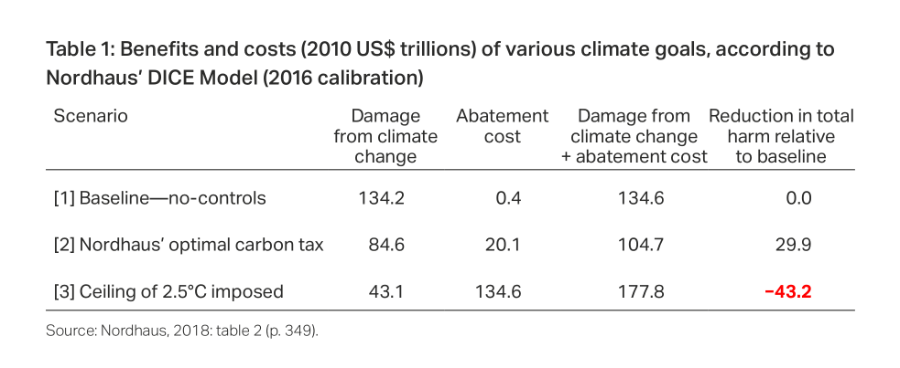The economic problem of the 1.5°C climate ceiling

In a recent essay and blog post, we explored the origins of the “10-years-to-save-the-Earth” climate change narrative, and also explained the origins of the “temperature ceiling” narrative, which suggests the maximum amount of atmospheric warming the planet could adjust to without causing ruinous harms to people and the planet. That particular ceiling now stands at 1.5 degrees Celsius, having worked its way down over the last several years from the prior accepted threshold of 2°C as little as five years ago.
To briefly summarize, both the 1.5°C catastrophe threshold, and the countdown timer to avoid it, come from a very large ensemble of speculative computer models forecasting:
- How greenhouse gas concentrations might increase in the future under various speculative “Storylines and Scenarios created by a subdivision of the United Nations Intergovernmental Panel on Climate Change”
- How much warming those gases will trap in the atmosphere
- How that warming will impact various human and non-human ecosystems and economic systems in the future
In this post, we turn to the question of what impact the goal of avoiding the largely speculative 1.5°C disaster threshold would have on Canada’s (and the world’s) overall economic health.
In short, economic analyses suggest that attempting to reduce greenhouse gas (GHG) emissions at the scale required to conform with the 1.5°C upper-limit models would cause considerably more harm to humans (and the ecosystems we are an integral part of) than doing nothing at all.*
In a recent study, Off Target: The economics literature does not support the 1.5°C climate ceiling, Fraser Institute senior fellows Robert P. Murphy and Ross McKitrick explore the history of this question, particularly the (often misrepresented) work of Nobel-winning economist William Nordhaus, who built much of his career conducting economic analysis of climate change policy proposals. As Murphy and McKitrick summarize:
"[W]e will reproduce two separate facets of Nordhaus’ results to show that they reject the 1.5°C target. First, we show that, as of the 2016 calibration of his Dynamic Integrated Climate-Economy (DICE) model, Nordhaus recommended an “optimal carbon tax” that would place the Earth on a trajectory to warm 3.5°C by the year 2100. Second, we show that Nordhaus’ 2016 results conclude that the effects of a 1.5°C ceiling on global warming would be so severe that it would be better for humanity to do nothing about climate change, rather than pursue such a stringent goal."
The table below shows the estimated benefits and costs of three different carbon tax scenarios modeled by Nordhaus—one where there are no (tax) controls implemented to limit GHG gases; one that strikes what Nordhaus considers an economically optimal result of reducing predicted climate change harms; and one where a hard climate change ceiling of 2.5°C is adopted, with the level of carbon taxation needed to keep global temperatures below that ceiling.

Unpacking this a bit for the non-economist, Nordhaus’s DICE model (part of the work he did that earned him the Nobel) suggested the damages from climate change without any controls would equal about US$134 trillion by 2100 (see row 1in the table and note that these figures are expressed in present-value terms from today’s perspective).
According to the Nordhaus model, that “optimal tax,” which would reduce U.S. economic output by US$20.1 trillion (measured from today’s perspective, discounting future dollars at the going rate of interest), would be expected to offset US$134.2 - US$84.6 = US$49.6 trillion in climate change damage that would occur in the absence of controls over GHG emissions. Put simply, Nordhaus’ “optimal tax” would do more good than harm, to the tune of avoiding a net US$29.9 trillion in economic harms from predicted climate change over whatever costs (harms) the tax itself would impose on the economy (see the last column in row 2 in the table, showing how much on net the “optimal carbon tax” scenario improves upon the baseline “no controls” scenario). That would represent a net social gain, though under that model, the world would still see 3.5 °C of global warming (which is not shown in the table, but appears elsewhere in Nordhaus’ results).
But when Nordhaus modelled what it would take (via a carbon tax) to limit the Earth’s temperature increase to 2.5°C, the outcome was much different. The economic harm of imposing a tax needed to prevent warming above 2.5°C would reach US$134.6 trillion. It’s true that such an aggressive tax would limit climate change damages to US$43.1 trillion, but even so, on net the costs of the tax would exceed these climate benefits by US$43.2 trillion relative to the “no controls” baseline (shown in the right column in the last row).
As for capping potential climate change to 1.5°C, as Murphy and McKitrick observe, “Nordhaus considered the 1.5°C ceiling so far out of reach that he didn’t even bother to model it as a policy option.” However, a simple exercise in multiplication would suggest that lowering the Nordhaus-modelled 2.5°C scenario down to 1.5°C (a 60 per cent reduction) would increase the net harms done to society proportionately, causing (43.2*1.6) or 69 US$trillion more economic costs to society as a whole than would allowing totally uncontrolled GHG emissions and consequent damages from climate change.
The current maximum heating threshold that IPCC models suggest will fall short of catastrophic levels is currently 1.5°C. Still other IPCC models of GHG emissions trajectories in the future suggest warming could be “locked in” in as little as 10 years without radical GHG emission-reduction policies such as the Trudeau government’s stated goal of achieving net-zero carbon emissions by 2050, for example, or Prime Minister Trudeau’s more recent pledge to reach net-zero carbon emissions from Canada’s electrical generation sector. But economic models by Nobel prize-winning economist Nordhaus (and others) suggest that the costs of achieving the big “net-zero by 2050” goal would cause much more harm to society than imposing no GHG emission controls at all.
*I do not advocate a do-nothing approach to climate change. In the next blog post, I will explore how we can increase society’s (and the environment’s) resilience to climatic change, and facilitate adaptation to change as it unfolds, rather than trying to predict it.

